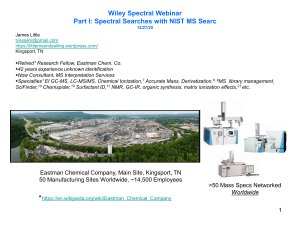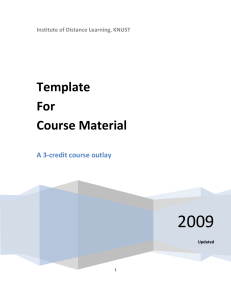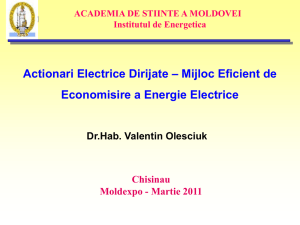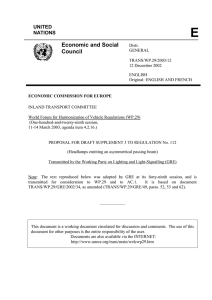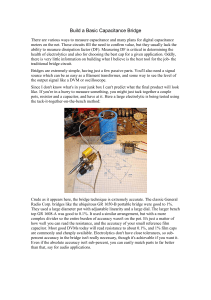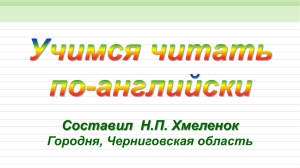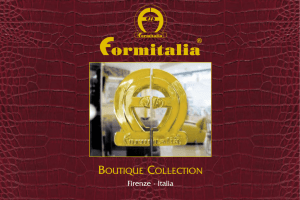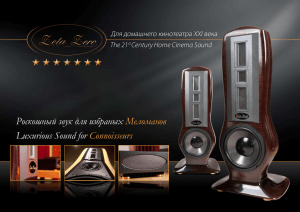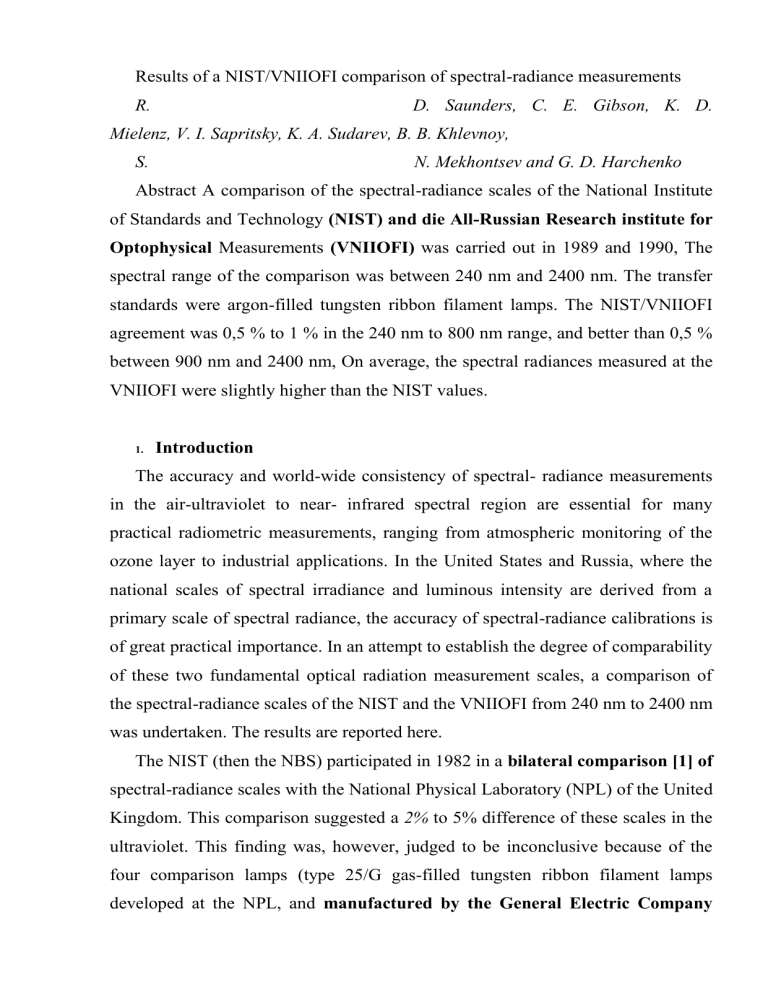
Results of a NIST/VNIIOFI comparison of spectral-radiance measurements
D. Saunders, С. E. Gibson, K. D.
R.
Mielenz, V. I. Sapritsky, K. A. Sudarev, В. B. Khlevnoy,
S.
N. Mekhontsev and G. D. Harchenko
Abstract A comparison of the spectral-radiance scales of the National Institute
of Standards and Technology (NIST) and die All-Russian Research institute for
Optophysical Measurements (VNIIOFI) was carried out in 1989 and 1990, The
spectral range of the comparison was between 240 nm and 2400 nm. The transfer
standards were argon-filled tungsten ribbon filament lamps. The NIST/VNIIOFI
agreement was 0,5 % to 1 % in the 240 nm to 800 nm range, and better than 0,5 %
between 900 nm and 2400 nm, On average, the spectral radiances measured at the
VNIIOFI were slightly higher than the NIST values.
1.
Introduction
The accuracy and world-wide consistency of spectral- radiance measurements
in the air-ultraviolet to near- infrared spectral region are essential for many
practical radiometric measurements, ranging from atmospheric monitoring of the
ozone layer to industrial applications. In the United States and Russia, where the
national scales of spectral irradiance and luminous intensity are derived from a
primary scale of spectral radiance, the accuracy of spectral-radiance calibrations is
of great practical importance. In an attempt to establish the degree of comparability
of these two fundamental optical radiation measurement scales, a comparison of
the spectral-radiance scales of the NIST and the VNIIOFI from 240 nm to 2400 nm
was undertaken. The results are reported here.
The NIST (then the NBS) participated in 1982 in a bilateral comparison [1] of
spectral-radiance scales with the National Physical Laboratory (NPL) of the United
Kingdom. This comparison suggested a 2% to 5% difference of these scales in the
ultraviolet. This finding was, however, judged to be inconclusive because of the
four comparison lamps (type 25/G gas-filled tungsten ribbon filament lamps
developed at the NPL, and manufactured by the General Electric Company
(UK)) were destroyed during shipment, and the remaining two lamps had also
suffered severe impacts.
In a later comparison of spectral-irradiance measurements [2], conducted in
1989 and 1990 under the auspices of the Comite Consultatif de Photometrie et
Radiometrie (CCPR), the measurements carried out at 350 nm by the NIST as pilot
laboratory showed general agreement among the participants with a maximum
difference of 3,65 % between the NIST and the VNIIOFI. Unlike the 1982
spectral-radiance results, in this comparison the agreement between the NIST and
the NPL was within 0,17% at 350 nm. Because the NIST scale of spectral
irradiance is based on the NIST scale of spectral radiance [3], it is hoped that
further bilateral comparisons of the spectral-radiance scales will help to resolve
some of the discrepancies in the results of the various comparisons and establish
better agreement among the national laboratories in reporting values of spectralradiometric quantities.
2.
Lamps
Each laboratory provided three spectral-radiance lamps for the comparison.
The NIST lamps, designated Q106, Q108 and Q109 and shown in Figure 1,
were type 30A/6V/T24 argon-filled tungsten ribbon filament lamps with fusedsilica windows, manufactured by the General Electric Company (US). The
filament of these lamps is 3 nun wide by 15 mm long. The spectral-radiance
calibrations of the lamps were performed for a rectangular target area 0,6 mm wide
by 0,8 mm long, marked by an alignment notch in one edge of the filament. The
lamps were operated on direct current The lamp current was measured with a
stable 0,01 ft resistor and a 5V2 digit voltmeter to within ±0,1 mA, and regulated to
within ±0,4 mA. Prior to calibration, each lamp was annealed for two hours at a
radiance temperature of 2350 °C.
The VNIIOFI lamps, designated N25, N57 and N186 and shown in Figure 2,
were type TRU 1100- 2350 argon-filled tungsten ribbon filament lamps with
ultraviolet transmitting windows, manufactured at the Moscow Lamp Factory. The
filament of these lamps is 2,8 ram wide by 20 nun long. The calibrated target
area (1,0 mm wide by 1,0 mm long) was marked by a wire pointer near the centre
of the ribbon. The lamps were operated on direct current which was measured to
within ±0,2 mA, and regulated to within ±0,2 mA.
From the spectral-radiance meaurements performed in the comparison, the
average radiance temperature of the lamps at 654,6 nm was approximately 2456 К
(NIST lamps) and 2319 К (VNIIOFI lamps).
3,
Measurement procedures and uncertainties
3.1
The NIST
The NIST measurements of spectral radiance [4, 5] were based on a
measurement chain starting from a standard black body at the freezing temperature
of gold, TAu = 1337,33 K, The gold-point black body was used to set the
temperature of a Quinn-Lee type vacuum tungsten ribbon filament lamp to 1337,33
К by spectral-radiance comparison at 654,6 nm.
The 1337 К lamp was used to determine the temperature of a General Electric
Company (UK) high- stability vacuum lamp at 1530 К by spectral-radiance
comparison at 654,6 nm. The 1530 К lamp was used to determine the
temperature of a variable-temperature black body up to approximately 2600 К
by spectral- radiance comparison at 654,6 nm. The calibration of the comparison
lamps was carried out by spectral-radiance comparison with the variabletemperature black body at wavelengths from 240 inn to 2400 nm. The black body
was set at temperatures to yield spectral radiances similar to those of the
comparison lamps in order to avoid reliance on large linearity corrections. All of
these calibrations were performed in the NIST Facility for Automated
Spectroradiometric Calibrations (PASCAL).
Following the 1989 NIST measurement of TAu [6] and the adoption by the
NIST in 1992 of the Bureau International des Poids et Mesures (BIPM) guidelines
for expressing uncertainties [7], the relative expanded uncertainties of the NIST
scale of spectral radiance were revised. The relative expanded uncertainty is equal
to к times the combined standard uncertainty, where &=the coverage factor=2. The
level of confidence corresponding to these relative expanded uncertainties is 95 %
(2d).
3.2
The VNIIOFI
The measurement method that was employed at the VNIIOFI is described in
[8], A variable-temperature black body and an electrically calibrated cavity
radiometer inside a vacuum chamber were used to measure the ratio of the total
radiant fluxes of the black body at temperatures near 1800 К and 2700 K. With the
radiometer moved off the axis of the black body and the black-body radiation
transmitting through a vacuum window, a spectroradiometer was used to measure
the ratio of the spectral radiance of the black body at these temperatures over a
range of wavelengths, as well as the ratio of the spectral radiance of the tungsten
ribbon filament lamp to the black body. The three ratios were used to compute the
spectral radiance of the lamps in absolute units.
4.
Comparison schedule
The comparison was initially intended to cover the range 255 nm to 2400 nm.
The NIST carried out measurements throughout this range. The VNUOFI
measured the NIST lamps down to 240 nm and the VNUOFI lamps down to 250
nm.
The following measurements were performed:
(a)
1989: initial calibration of NIST lamps at the NIST, and VNUOFI lamps at
the VNUOFI.
(b)
1989: exchange of lamps, calibration of VNUOFI lamps by the NIST, and
vice versa.
(c)
1990: exchange of lamps, repeat calibration of lamps by the NIST and the
VNIIOFI.
(d)
1990: repeat measurement of lamp Q108 by the
VNUOFI.
Accordingly, lamp Q108 was measured twice by each laboratory. Lamps Q106
and Q109 were measured twice by the NIST and once by the VNUOFI. Lamps
N25, N57 and N186 were measured twice by the VNUOFI and once by the NIST.
The comparison was “blind”; that is, results were not revealed until repeat
calibrations had been completed.
5.
Measurement results and data analysis
The difference between NIST and VNUOFI measurements is expressed in the
form
percentage difference
= 100 x (Lx, vNiiovi — LX,NIST)/LX,NIST> (1)
The VNUOFI spectral-radiance values were consistently higher than the NIST
values. The percentage differences for the individual lamps were between 0,1 %
and 2,7 % in the 240 nm to 800 nm range, and between 0,1 % and 1,7 % in the 900
nm to 2400 nm range.
6.
Conclusion
The results of the comparison are plotted in Figure 3. The solid lines represent
the combined uncertainties of die ratio measurement of a particular lamp due to the
combined uncertainties reported by the NIST and the VNUOFI. As may be seen
from the figure, most of ttie reported measurements fall within the expected range.
The average difference is within 0,5 % to 1 % in the 240 nm to 800 nm range, and
better than 0,5 % between 900 nm and 2400 nm. This agreement is within the 95%
confidence level of the comparison at all wavelengths. In fact, the overall
agreement is within, the 67% confidence level at all except three wavelengths
(1=655 nm, 700 nm and 2300 nm).
It was noted that, overall, the average spectral radiances measured at the
VNUOFI were slightly higher than those measured at the NIST at all but three
wavelengths (A=1550nm, 1700 nm and 2000 nm). This may indicate a small
difference in the temperature scales maintained at the two laboratories. Figure 4
shows the average difference from the intercomparison and the results of a
calculation based on Wien’s approximation to Planck’s law for black-body
radiation. The solid line represents the spectral radiance ratio (Wien
approximation, c2=second radiation constant),
Lx (A, 2461 K)/LA (A, 2460 K)
= exp {(c2/A) [1/(2460 K) - 1/(2461 K)]}, (2)
of two black bodies at 2461 К and 2460 K. This curve resembles the observed
overall NIST and VNUOFI agreement, from which one might conclude that the
VNUOFI temperature scale is higher than the NIST scale by 1 K, assuming that
the trend evidenced by the average difference is indicative of a systematic
correction. The small difference is, however, within the uncertainty of this
comparison, and also within the uncertainties of the NIST and VNUOFI radiance
temperature scales.
The NIST and VNUOFI agreement for the individual lamps indicated
differences outside the expected range shown by the solid lines in Figure 3 in a
number of individual measurements at specific wavelengths. The percentage
differences of the results obtained by the two laboratories exceeded the 95%
confidence level in 17 % of the individual measurements on the NIST lamps, and
41% of the individual measurements on the VNUOFI lamps. This suggests that the
NIST lamps may have been more stable during the comparison than the VNUOFI
lamps, and that the uncertainty estimates of individual lamp measurements may not
adequately represent lamp stability. The agreement in the individual measurements
on the NIST lamps was better, as can be seen from the distribution of points in
Figure 3. The mean difference of the measurements on the NIST lamps was 0,078
% and on the VNUOFI lamps it was 0,81 %. This difference could in part be due to
operational aspects of employing the two different lamps. The different bases and
filament structures of the lamps may be the cause of alignment variance and hence
result in measurement differences.
Note. Specific firms and trade names are identified in this paper for the sole
purpose of adequately describing experimental or test procedures, in no event
does such identification imply recommendation or endorsement by the National
Institute of Standards and Technology of a particular product; nor does it imply
that a named instrument is necessarily the best available for the purpose it serves.
Acknowledgements. We would like to thank John Jackson for assisting in
taking the data and Dr Carol Johnson for her comments and assistance with the
analysis.
